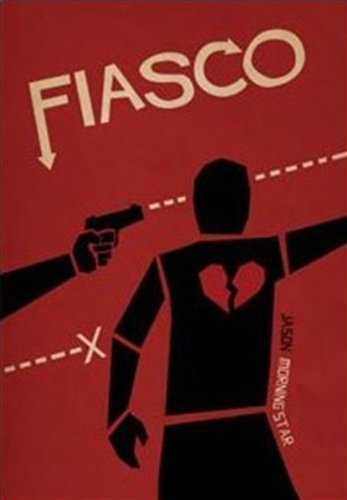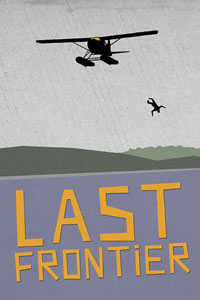You Should Be Playing…
Fiasco
In a nice Southern town, a web of infidelity, drug abuse, and old feuds twists into a single moment of desperate violence.
During the opening night of Eidelsburg Repertory Theatre, a villainous stage manager manipulates the stars of the show into actual murder out of sheer love of stagecraft.
Out in McMurdo Station, Antarctica, an FBI agent two weeks from retirement tries to unravel a mystery surrounding a vacationing son of a Saudi sheik, his two lovers, and a shipping container filled with two hundred kilos of hot Russian firearms.
Each and every one of these is a fiasco, and no character involved walked away unscathed. Most, in fact, did not survive to see the epilogue.
 Written by Jason Morningstar, and published by Bully Pulpit Games in 2009, Fiasco is a game of powerful ambition and poor impulse control. Inspired by the tradition of American cinema surrounding small people wanting more and the terrible lengths they will go to achieve it, Fiasco is an immensely fun game of personally wrought disasters for three to five players.
Written by Jason Morningstar, and published by Bully Pulpit Games in 2009, Fiasco is a game of powerful ambition and poor impulse control. Inspired by the tradition of American cinema surrounding small people wanting more and the terrible lengths they will go to achieve it, Fiasco is an immensely fun game of personally wrought disasters for three to five players.
It is run in a troupe style format, with no one player serving as a game master. Instead, each player takes a turn as a narrator, telling the tale of their character’s plans and how these plans go spectacularly awry. Think of it like writing, directing and starting in your own personal Cohen brothers film. While having at least a player or two who have played before will speed the game up immensely, the most necessary component for the game is the willingness to follow a narrative and an appreciation for extremely black comedy. Fiasco itself is only 132 pages, and can be ordered for $25 from Indie Press Revolution or Amazon, with the pdf version available for $12 from DriveThruRPG.
Gameplay
At the start of a game of Fiasco, the players roll two sets of six-sided dice. These dice are then assigned to a series of Elements, with the Element of a Relationship existing between a player and each of the two players immediately to either side of them. These Relationships vary from playset to playset, but often include family, crime, and sex, in some combination thereof. Additionally, at least one Element each of Need, Location, and Object will also be assigned between two players, similar to the Relationships. That Element relates to those characters either in their background or in the process of the narrative.
Every Element has both a Category and a Detail, with the Category serving as a broad stroke, while the Detail gives specifics. A Detail is set after the Category, and may be set by any player during set up. As such, one player could decide to give a Category of Romance to the Relationship between two other players at the table, followed by another player determining the Detail of Bitter Ex-Lovers.
Once all the Elements have been detailed, the players decide who their Characters are, giving brief descriptions and pertinent information going into the game. Play begins with one player taking the role of Narrator for a scene that focuses on their character. Players can choose to decide how a scene is set up, or whether the scene goes well or poorly for their character, but not both. The rest of the players will decide the other factor. Once that scene ends, the player receives a die based on the outcome of the scene, and either keeps the die or gives it away, depending on how close the game is to the end. Play then passes to the next player, who takes on the role of Narrator for their character’s scene, and so forth until half the dice have been assigned.
At this point in the narrative, things start going wrong. Thus, the Tilt is introduced as an additional Element, which must be incorporated into the latter half of the scenes, and, invariably, things continue going wrong. Like other Elements, the Tilt has a Category and Detail, and range from murderous killing sprees to “A stupid plan, executed flawlessly.”
Once all the dice have been assigned, the narrative reaches its climax, and players determine their characters’ Aftermaths. Depending on the luck of their dice, characters may wind up broken, dead, back to where they started, or getting off scot-free. Play then closes out with a narrative montage, as each player takes turns describing a single image of what happens to their characters in response to their Aftermaths. Once the final montage scene is resolved, the game closes.
Going Full Tilt
Fiasco is a game that can be played with little to no experience or prep work. While an experienced Fiasco player may know several tricks and permutations in handling the narrative, most of these are similar to techniques from improvisational theater. While players not used to narrative games (or the source material from cinema) generally take a little longer to get used to the process, by the time of the Tilt, most players have reached a level of comfort with the game that few other games produce. Game play of Fiasco is, by its nature, highly unpredictable and incredibly intuitive, as it asks players to simply tell stories with the cooperation of the other players. This cooperation is what makes the game truly fun, as players watch while the seeds they plant in their turns as Narrator come to blossom in unexpected ways under the care of other Narrators.
A game of Fiasco generally takes a total of two to three hours to play, with the latter half of the game generally flowing much faster than the former. As the dice pool begins to dwindle, the strategy of whether a scene will go well or poorly comes into play with players gleefully accepting bad turns for their characters to allow for positive turns for other characters. Even with taking the suggested break at the Tilt, a game of Fiasco would be difficult to stretch past the three and a half hour mark. The combination of this speed, along with the ease of the rules and the lack of prep work, makes Fiasco a perfect game for both convention and casual game nights.
While the core book of Fiasco contains only four scenarios, the nature of the game has led to dozens of additional scenarios available online for free. Additionally, Bully Pulpit Games has released a companion book to Fiasco with alternative Tilt and Aftermath tables, as well as featuring a Playset of the Month on their website.
The Playsets of the Month run the gamut from similar to the ones presented in the core book (such as one featuring the antics of News Channel Six), to the theater-inspired Break a Leg, to the Lovecraftian horror of Operation Zebra.
Each Playset of the Month is available for free, and can be easily copied to create entirely new playsets of a writer’s own choosing. Each playset alone offers 144 different Elements to fill out the set up, with only two per player being selected. The replay value of each playset alone is exceptional, and no two games of Fiasco will play out the same way. For some of your characters, that will be a good thing.
Fiasco is a game for players of all temperaments and levels of skill. It takes the most basic element of tabletop role-playing – telling an engaging story as a group – and creates a ruleset to keep it fun and fast. While a game of Fiasco will not likely change a person’s life, it is an immensely enjoyable way to spend an afternoon, and can serve as a wonderful gateway game to bring people into the hobby. Like a good dark comedy, a game of Fiasco is approachable and familiar, yet contains just enough strangeness to make it unique.
And that is why you should be playing Fiasco.
David Gordon is a regular contributor to the site. A storyteller by trade and avowed tabletop veteran, he is always on the lookout for creative tabletop games. He can be reached at dave@cardboardrepublic.com.
You can discuss this article and more on our forums!
Photo Credits: Fiasco and Last Frontier by Bully Pulpit Games.


